Eggplants are not very demanding on growing conditions in the south, and even in the north, indoors, they are not as demanding as peppers. Therefore, yellowing of leaves occurs due to prolonged exposure to unfavorable factors. If the impact is short-lived, the crop may not respond.
Peppers are an indicator (when grown in the same greenhouse or on the same plot), since the undesirable effects on them manifest themselves immediately and most strongly.
|
Most often, eggplants turn yellow in a greenhouse due to improper care. |
Transplanting
After planting seedlings, eggplant leaves often turn yellow. This is the acclimatization of culture in new conditions. The whole plant takes on a yellowish tint.
|
The yellowness of the lower leaves is more intense than at the top, and they lose turgor, although they do not droop. |
What to do? Nothing. After planting, the crop is sick for some time, but after 3-6 days it gets used to the new conditions, and the natural color is restored.
If eggplants remain yellowish for a long time, they are sprayed with growth stimulants Zircon or Epin.
Nitrogen deficiency
Eggplants love rich, fertile soil, but do not require heavy fertilizing. However, in poor soils they require large amounts of nitrogen. The deficiency of the element is especially pronounced in the first half of the growing season before fruiting begins.
During the fruiting period it is found only on very poor soils. The top of the plant and the young leaves of the upper tier acquire a light green color.
|
As nitrogen deficiency increases, the leaves turn yellow, and yellowing begins in the middle tier. Eggplants grow poorly and look underdeveloped with small leaves. |
Restoration activities. Plants are fed with urea, nitroammophos, ammonium nitrate, and humates. Organic fertilizers are not used before fruiting begins, since the crop will begin to grow and will not bloom for a long time (in the northern regions this is a complete loss of the crop).
If signs of nitrogen deficiency appear after the start of fruiting, then it is better to fertilize with organic matter. Eggplants will make up for the deficiency of the element, will grow and fully bear fruit. For feeding 2 cups of manure infusion or green fertilizer dilute in 10 liters of water and water the plants. On poor soils, take 3 cups of organic infusion per 10 liters, after thoroughly watering the crop.
Eggplants need nitrogen most of all, so a high concentration of fertilizers can only benefit them. If there is a deficiency of the element, 1-2 feedings are carried out until the signs of nitrogen starvation completely disappear. Next, they move on to the usual fertilizer application regime.
Potassium deficiency
There are two reasons for potassium deficiency:
- low content of the element in the soil;
- high temperature in the greenhouse. During prolonged intense heat (the temperature outside is above 32°C, and in the greenhouse above 36°C), potassium ceases to be absorbed by plants, even if its content in the soil is sufficient.
The leaves curl up in a boat, a brown-yellow-brown border appears along the edges, which then dries out and crumbles. With severe deficiency, the leaf becomes brownish.
|
If potassium deficiency appears during the fruiting period, then eggplants also shed their ovaries. |
Troubleshooting. If there is a lack of potassium in the soil, the crop is fed with potassium sulfate or complex fertilizers containing potassium: monopotassium phosphate, kalimag, nitrophoska, nitroammofoska.
In extreme heat, especially in a greenhouse, fertilizing is useless, since potassium is not absorbed, no matter how much it is contained in the soil. Therefore, they cool the earth and, if possible, the air.
To lower the soil temperature, water the eggplants with cold water (temperature not lower than 15°C) and, if there is a deficiency of potassium, fertilize them immediately. If there is enough potassium in the soil, then no additional fertilizing is done. Watering should be done at night so that the soil does not heat up too much after watering.
The tops are sprayed with cold water in the evening, and then the leaves are treated with a solution of potassium fertilizer.
Lack of microelements
Very common on poor podzolic and peaty soils. It can manifest itself either independently or against the background of nitrogen deficiency. It appears at any time, but usually during the fruiting period.
|
Deficiency very rarely occurs in any one element; more often it is a complex lack of nutrients. |
The tips of the leaves begin to dry out and crumble (lack of calcium), yellow-brown specks appear on the lower old leaves, reminiscent of late blight spots (lack of zinc), the top becomes yellowish-green, and the leaves curl slightly inward (boron deficiency). The foliage takes on a light shade, and light yellow spots of a vague shape may appear on the lower tier (lack of magnesium).
Control measures. Eggplants are fed with a solution of complex fertilizers with microelements for tomatoes and peppers, Malyshok, Krepysh, Mortar, Tomato Crystal.
Ash infusion copes well with the lack of microelements. 1 glass of infusion is dissolved in 10 liters of water and root feeding is carried out.
Prolonged cold snap
For this reason, eggplant leaves turn yellow most often in the northern regions.At a daytime temperature of 12-14°C, plants stop developing. And if we take into account that at night the temperature is even lower, the plant goes into “economy mode”, maintaining only the growth point. The lower leaves turn yellow and even fall off during prolonged cold spells. The entire plant takes on a pale yellow tint. The ovaries fall off.
|
With prolonged cold weather (temperatures below 15°C for more than 5-7 days and cloudy conditions), the metabolic process in eggplants irreversibly changes and they will not bloom or bear fruit even if the weather continues to be quite good. If they survive, they will continue to grow simply as an ornamental shrub without flowers or fruits. |
Preventive measures. If possible, eggplants are covered with spunbond even in a greenhouse (at a temperature of 15°C and below). This is especially necessary at a young age, before flowering begins.
- If possible, hot bricks from the bathhouse are laid out in the passages. As a result, the air temperature rises by 5-6°C, which allows eggplants to develop normally.
- Water the crop at this time only with warm water.
- The greenhouse is ventilated no more than 15-20 minutes a day just to prevent condensation from accumulating. The rest of the time it is kept completely closed.
- To increase resistance to adverse factors, eggplants are sprayed with growth stimulants Zircon or Epin.
Thickened planting
When the planting is dense, the lower leaves have no chance of getting through to the light; they cease to perform their main function (photosynthesis), so the eggplants drop them.
|
The same thing happens when the bushes grow strongly and the tops close together. As it is no longer needed, the lower leaves turn yellow and fall off. When plants become very dense, the leaves of the middle tier also fall off. |
Solution to the problem. When planting frequently, eggplants are thinned out by removing excess bushes. No matter how much you feel sorry for them, when they grow up a little, it will be a complete jungle, where it will be difficult for the crop to grow, let alone bear fruit. The distance between plants should be at least 60 cm for low-growing varieties and 80-100 cm for tall ones.
If the culture has not been formed, then when the tops close, practically no light penetrates to the lower leaves; it is always dark and damp there. And this is a favorable background for the development of diseases.
Therefore, eggplants are formed by cutting 1-2 leaves per week and removing side shoots. If this is not done, the lower leaves will turn yellow and fall to the level at which at least some sunlight reaches.
Improper watering
Plants require abundant watering, but do not like waterlogged soil.
|
With a high moisture content in the soil, eggplants acquire a yellowish tint, the lower leaves turn yellow and droop, although they do not lose turgor. This happens because the roots do not have enough air, and they begin to suffocate, get wet and rot. |
Preventive actions. In the northern regions, in a greenhouse, eggplants are watered once every 3-5 days (about the same as tomatoes), and only during prolonged intense heat, watering is done once every 2-3 days. This crop is quite drought-resistant and can tolerate drying out of the soil for a short time without consequences.
In open ground in the south, during prolonged damp weather, eggplants are loosened every other day. It is advisable to make a canopy over them so that the plot does not become waterlogged.
pasynkovanie
Eggplants react poorly to the removal of large numbers of leaves and shoots from the bushes at once.
|
When trimmed excessively, the plants look depressed and acquire a yellowish tint.The lower remaining leaves may become deep yellow and dry out, while those in the middle tier may turn yellow and droop, although they later recover. |
Correct formation of bushes. Eggplants are not tomatoes that can easily They tolerate quite severe pruning. It is necessary to form a culture from the moment it has lateral or basal shoots.
From this time on, no more than 2 leaves and 2 shoots are removed simultaneously every 5-7 days. With more severe pruning, the plants become sick, their growth and fruiting are delayed.
If the crop was started and was not formed until the tops closed, then no more than 2 leaves and one stepson can be removed at the same time. Then, every 3-4 days, one leaf and one shoot are removed until the plants are fully formed.
Mosaic of eggplants
Viral disease. More common in the south. In the central regions in greenhouses it appears very rarely when combined growing with tomatoes. It is affected by several viruses, the most common being the tobacco mosaic virus.
|
When the virus is infected, randomly alternating light green, yellow-green, and normally colored areas appear on the leaves. |
Affected leaves take on a light green color. Then these spots become necrotic and dry out, the tissue crumbles and falls out, and the leaf dries out. The disease quickly spreads throughout the plant. Yellow spots appear on the fruits, they become ugly and unsuitable for food.
Terms of distribution. The virus is transmitted mechanically and by pests. Preserves on affected seeds and weeds.
What to do if eggplants are sick
Diseased plants are destroyed.Since eggplants are a very valuable crop, especially in the northern regions where growing a good harvest is problematic, you should not waste time on treatment, since one diseased plant will infect the entire greenhouse, and not only eggplants, but also peppers, cucumbers and tomatoes.
At the same time as diseased eggplants, diseased plants of other crops are removed when they are grown together.
If there is a tense background according to the mosaic, then varieties resistant to the disease are grown: Epic, Valentina.
|
The symptoms of mosaic are very similar to the symptoms of magnesium deficiency. If there is a lack of an element, yellowish spots appear along the veins, but they are not light yellow, but darker, the color is the same as that of a dried leaf. The veins themselves remain green, while with mosaic they are highlighted. The photo shows a lack of magnesium. |
What to do? Feed with Kalimag. If after this there is no further increase in signs, then another feeding is done. The leaves should acquire a natural green color without spots.
If this does not happen, it is better to remove the bush; it is possible that it is still a virus, but its development is slow, and the disease can affect the entire plot. If the eggplants have returned to their natural color, then there is no need to worry - the problem has been resolved.
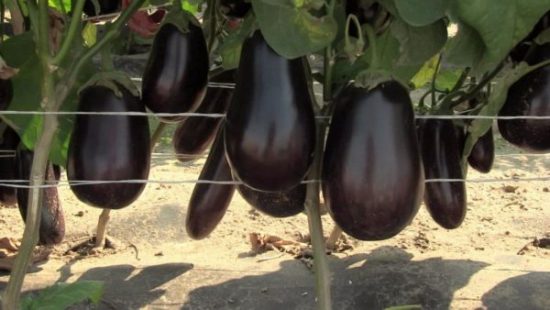
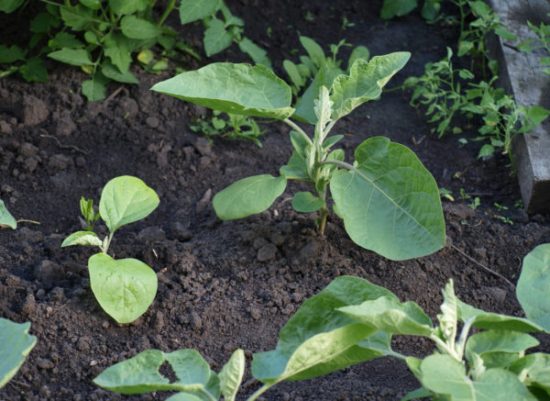
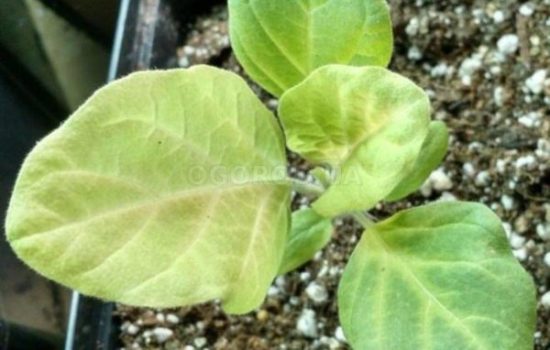
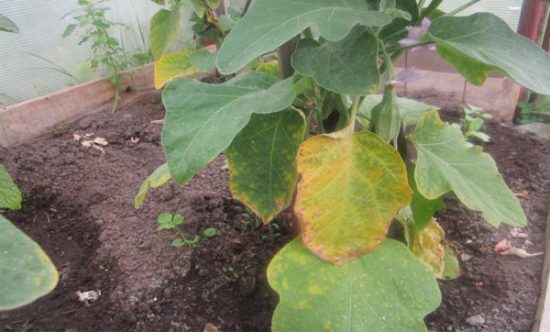
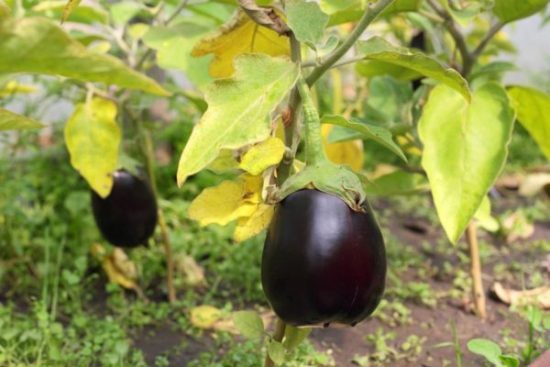
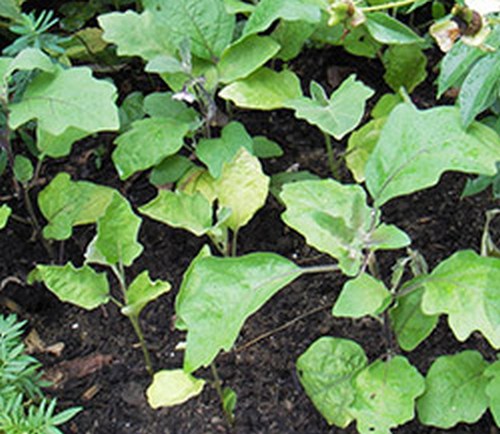
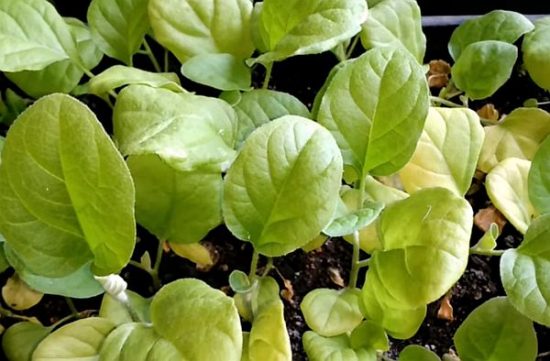
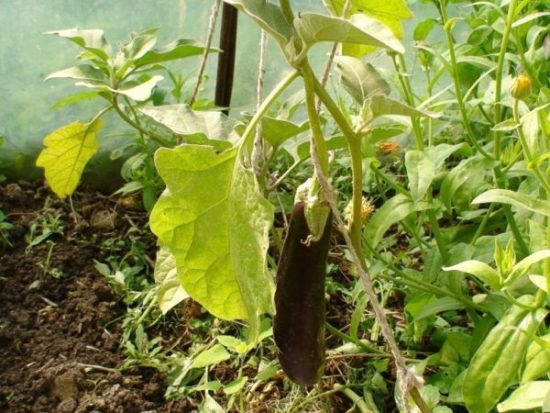
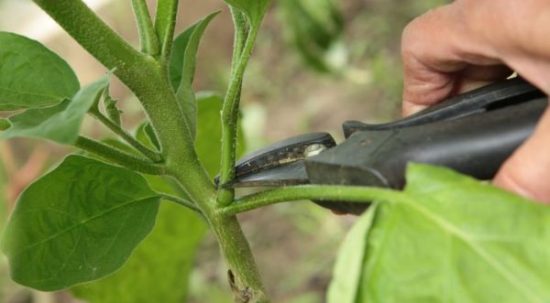
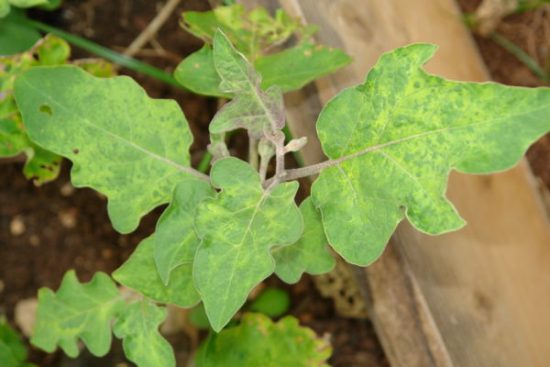
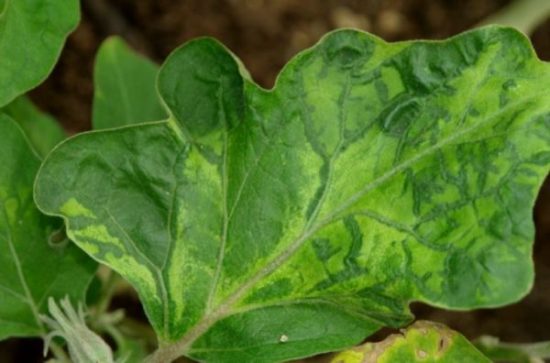

 (4 ratings, average: 4,00 out of 5)
(4 ratings, average: 4,00 out of 5) CUCUMBERS NEVER GET SICK, I'VE BEEN USING ONLY THIS FOR 40 YEARS! I SHARE A SECRET WITH YOU, CUCUMBERS ARE LIKE THE PICTURE!
CUCUMBERS NEVER GET SICK, I'VE BEEN USING ONLY THIS FOR 40 YEARS! I SHARE A SECRET WITH YOU, CUCUMBERS ARE LIKE THE PICTURE! You can dig a bucket of potatoes from each bush. Do you think these are fairy tales? Watch the video
You can dig a bucket of potatoes from each bush. Do you think these are fairy tales? Watch the video
 How our fellow gardeners work in Korea. There is a lot to learn and just fun to watch.
How our fellow gardeners work in Korea. There is a lot to learn and just fun to watch. Eye trainer. The author claims that with daily viewing, vision is restored. They don't charge money for views.
Eye trainer. The author claims that with daily viewing, vision is restored. They don't charge money for views. A 3-ingredient cake recipe in 30 minutes is better than Napoleon. Simple and very tasty.
A 3-ingredient cake recipe in 30 minutes is better than Napoleon. Simple and very tasty. Therapeutic exercises for cervical osteochondrosis. A complete set of exercises.
Therapeutic exercises for cervical osteochondrosis. A complete set of exercises. Which indoor plants match your zodiac sign?
Which indoor plants match your zodiac sign? What about them? Excursion to German dachas.
What about them? Excursion to German dachas.